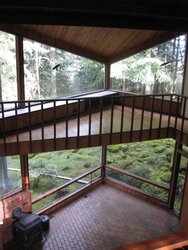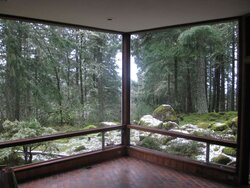Great advice and recommendations everyone. Thanks again!
Here's an update since my last post . . .
Regarding some of the efficiency issues. I had our local electric co-op come out to inspect the house. Looks like everything that could be done was done prior to our buying the house. The crawlspace was re-insulated and a new weather barrier installed, the attic was insulated, (it hadn't been), all duct work was sealed and insulated, walls were inspected and drafts sealed.
I also ordered new gaskets from VC and replaced them. I do notice a slower burn, but it's nothing to write home about. I also bought a thermometer - what a great purchase. Being able to see when the stove is burning at an ideal temp, and being able to control it is just great. I can only wonder how many hours I logged in the creosote zone before now. I also picked up a moisture meter. Love it! All of our wood tests out below 20% moisture, unless I stick it in the bark which can hold a lot of moisture - in which case I usually scrape it off before burning. Next I'm going to vacuum out the stove.
As for my thermostat. It's broken. The coil and lever simply aren't there. There's a broken piece of chain attached to the rear air intake flap. That's all. I attached a piece of copper wire to it that I can hook over the top of the rear heat shield. I now manually open and close it to keep the temp in the ideal zone. Gotta look into replacing that.
I usually leave the side air intake all the way open. I find that if I close it completely (with the rear intake also closed), the fire will simply go out. I've tried this a couple times and when I notice the temp drops dramatically, and open the top to find a pile of smoking wood, covered with brown residue, and no flames.
And finally, the windows. I had a weatherization company come out on Monday to have a look. They're returning with their chief field estimator sometime soon. It's gonna be a task. I was told underwriter compliant windows can't exceed 40sq ft, (our largest is about 75sq ft), so we'll definitely have to remove and section ours out, which is a shame. And they're simply much too large for storm windows. He ball-parked the job for the whole house at somewhere between $30k-$50k. Blam!!
So . . . with Dec 31st quickly approaching, (and with it a federal tax credit deadline), and since I live in Oregon and have to pay to remove and destroy my VC should we ever sell the house, and with window replacements being an extremely expensive, long-term undertaking, I ask your advice:
Door #1 = New stove and burn less wood? (assuming the wood is properly seasoned, of course)
Door #2 = Keep the ol' VC and just wait until the windows can eventually be replaced. (Curtains sound like my best option).
Oh, for fun . . . I've attached some pictures so everyone can see what 'the little VC that could' is up against

Thanks again for all the super advice and for taking the time to share it.


 Perhaps you are talking about a face cord. A cord of wood is 128 cu. in. A face cord is a stack of wood usually cut to 16" length and is 4' high and 8' long. There is a big difference.
Perhaps you are talking about a face cord. A cord of wood is 128 cu. in. A face cord is a stack of wood usually cut to 16" length and is 4' high and 8' long. There is a big difference. 

